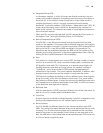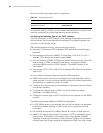
OSPF 91
Configuring the OSPF STUB Area
STUB areas are special LSA areas in which the ABRs do not propagate the learned
external routes of the AS. In these areas, the routing table sizes of routers and the
routing traffic are significantly reduced.
The STUB area is an optional configuration attribute, but not every area conforms
to the configuration condition. Generally, STUB areas, located at the AS
boundaries, are those non-backbone areas with only one ABR. Even if this area has
multiple ABRs, no virtual links are established between these ABRs.
To insure that routes to the destinations outside the AS are still reachable, the ABR
in this area generates a default route (0.0.0.0) and advertises it to the non-ABR
routers in the area.
Note the following items when you configure a STUB area:
■ The backbone area cannot be configured as a STUB area, and virtual links
cannot pass through the STUB area.
■ If you want to configure an area as a STUB area, all the routers in this area
should be configured with the stub command.
■ No ASBR can exist in a STUB area and the external routes of the AS cannot be
propagated in the STUB area.
Perform the following configuration in OSPF Area view.
By default, the STUB area is not configured, and the cost of the default route to a
STUB area is 1.
Configuring NSSA of OSPF
An NSSA is similar to a STUB area. However, NSSA does not allow importing
AS-External-LSAs (type-5 LSAs) although it does allow importing
NSSA-External-LSAs (type-7 LSAs). ASBRs can be configured to convert type-5
LSAs to type-7 LSAs to allow advertising of type-5 LSAs within the NSSA. Similarly,
ABRs can be configured to reconvert the type-7 LSAs to type-5 LSAs as these LSAs
leave the NSSA.
For example, in Figure 5, the AS running OSPF includes three areas: Area 1, Area 2
and Area 0. Among them, Area 0 is the backbone area. Also, there are other two
ASs running RIP. Area 1 is defined as an NSSA. After RIP routes of Area 1 are
propagated to the NSSA ASBR, the NSSA ASBR generates type-7 LSAs which are
propagated in Area 1. When the type-7 LSAs reach the NSSA ABR, the NSSA ABR
translates it into a type-5 LSA, which is propagated to Area 0 and Area 2. On the
other hand, RIP routes of the AS running RIP are translated into type-5 LSAs that
Table 36 Configuring an OSPF STUB Area
Operation Command
Configure an area as the STUB area stub [no-summary]
Remove the configured STUB area undo stub
Set the cost of the default route to the STUB
area
default-cost value
Remove the cost of the default route to the
STUB area
undo default-cost


















